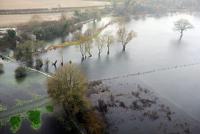-
U.K. government rejected flood warnings from own advisers

Critics charge that the U.K. government was warned by both the government’s own climate change experts and outside consultants that there was a need to take urgent action to protect the increasing number areas in Britain which are becoming susceptible to flooding, but that the government rejected the advice. Despite the urging of its own climate experts, the U.K. government in October, just a few weeks before the devastating flooding in Cumbria, decided not to develop comprehensive strategy to address flood risk.
-
-
Pipeline replacement programs are effective
Aging infrastructure, including roads, bridges, and natural gas and water mains, is an increasing concern. In 2011 the U.S. Pipeline and Hazardous Materials Safety Administration issued a call to action to accelerate the repair, rehabilitation, and replacement of the highest-risk pipeline infrastructure. Invisible gas leaks from aging or damaged pipelines cost U.S. consumers billions of dollars every year, contribute to global warming and, in rare cases, cause dangerous explosions. Pipeline replacement programs in cities, however, can cut natural gas leaks by 90 percent, a new study finds. “The surprise wasn’t that replacement programs worked,” said the study’s lead author. “It was that they worked so well.”
-
-
Insider threats, organizational rigidity pose challenges for U.S. national security: Study
U.S. national security faces rising challenges from insider threats and organizational rigidity, a Stanford professor says. A new study says that in the past five years, seemingly trustworthy U.S. military and intelligence insiders have been responsible for a number of national security incidents, including the WikiLeaks publications and the 2009 attack at Fort Hood in Texas that killed 13 and injured more than 30. The study’s author acknowledges the difficulties of learning lessons from tragedies like 9/11, the NASA space shuttle accidents, and the 2009 Fort Hood shooting. She notes that policymakers tend to attribute failure to people and policies. While seemingly hidden at times, the organizational roots of disaster are much more important than many think, she added.
-
-
Big Data, Internet of Things enable real-time probabilistic risk analysis
Statistical models are playing an increasingly important role in risk analysis and helping the United States and other countries around the globe mitigate the effects of natural and man-made disasters. With the increased ability to collect data through the Internet of Things and analyze this data in real time, the field of risk analysis is entering an exciting new phase based on real-time probabilistic risk analysis. This emerging paradigm can enable humans to better manage risks associated with complex systems, including space shuttles launching into orbit, illicit nuclear materials crossing national boundaries and the side effects of chemicals and even medical drugs.
-
-
Climate change risk assessment: “The inconvenient may become intolerable”
An international group of scientists, energy policy analysts, and experts in risk from finance and the military on Monday released a new independent assessment of the risks of climate change, designed to support political leaders in their decisions on how much priority to give to the issue. Their report argues that the risks of climate change should be assessed in the same way as risks to national security or public health. This means focusing on understanding what is the worst that could happen and how likely it is to occur. The report identifies thresholds beyond which “the inconvenient may become intolerable.” These include limits of human tolerance for heat stress, and limits of crops’ tolerance for high temperatures, which if exceeded could lead to large-scale fatalities and crop failure; as well as potential limits to coastal cities’ ability to successfully adapt to rising sea levels.
-
-
Climate change risk assessment: Policy brief
The international group of experts which yesterday released the report Climate Change: A Risk Assessment (University of Cambridge, July 2015), summarized their recommendations in a policy brief. “An honest assessment of risk is no reason for fatalism. Just as small changes in climate can have very large effects, the same can be true for changes in government policy, technological capability, and financial regulation,” the experts write. “Leadership can make this virtuous circle turn faster, more fully mobilizing our ingenuity, resources, and commitment. In this way, the goal of preserving a safe climate for the future need not be beyond our reach.”
-
-
Emerging threats require a new social contract between the state, citizens: Study
Technological advancements create opportunities for governments and the private sector, but they also pose a threat to individual privacy and individual – and public — safety, which most Americans look to the government to protect. The authors of a new book on emerging threats argue that while, at one time, “the government used to be our sole provider of security,” companies which store troves of private information are also key to Americans’ privacy and security. They say that the United States may need a new social contract between the state and its citizens on matters of security and privacy. “The old social contract has its roots in the security dilemmas of the Enlightenment era,” they write. “In our new era, everyone is simultaneously vulnerable to attack and menacing to others. That requires a different, more complex social contract — one that we are just starting to imagine.”
-
-
Extreme geohazards: Reducing disaster risk, increasing resilience
Extreme hazards — rare, high-impact events — pose a serious and underestimated threat to humanity. The extremes of the broad ensemble of natural and anthropogenic hazards can lead to global disasters and catastrophes. Because they are rare and modern society lacks experience with them, they tend to be ignored in disaster risk management. While the probabilities of most natural hazards do not change much over time, the sensitivity of the built environment and the vulnerability of the embedded socio-economic fabric have increased rapidly.
-
-
Predicting the scope of flash flooding
Devastating flooding, such as Iowa’s flood of 2008 — which swamped many Iowa communities, along with ten square miles of Cedar Rapids — are notoriously difficult to predict. Researchers set out to gain a better understanding of flood genesis and the factors impacting it. They were able to do this by zeroing in on the impacts of certain rainfall patterns at the smallest unit of a river basin: the hillslope scale.
-
-
U.S. yet to develop a strategy to secure nation’s critical infrastructure
For years, the U.S. government has warned federal and state agencies about the threat posed by hackers who may target computer systems responsible for operating nuclear plants, electric substations, oil and gas pipelines, transit systems, chemical facilities, and drinking water facilities. In February 2013, President Barack Obama issued a directive stating, “It is the policy of the United States to strengthen the security and resilience of its critical infrastructure against both physical and cyber threats.” Two years later the federal government has yet to develop or adopt a consensus on how to secure America’s critical infrastructure from cyber criminals.
-
-
Ohio helps resident pay for tornado safe rooms
In recent years, Ohio has averaged twenty-three tornadoes annually. The state also experienced winds topping 70 mph during Hurricane Ike in 2008, 100 mph in the derecho during the summer of 2012, and near hurricane-force winds along Lake Erie in northeastern Ohio during superstorm Sandy in the fall of 2012. Many Ohio residents living along “Tornado Alley” have rehearsed their escape plans several times to prepare for the next time a tornado touches ground. To offer residents better protection, since 2013 the Ohio Emergency Management Agency(EMA) has been helping qualified homeowners pay for safe rooms which can withstand the most destructive windstorms.
-
-
Reducing the impact of extreme weather
How do we reduce the impact of extreme weather today while preparing ourselves for future changes? What can we do to build our resilience? A new report from the Royal Society investigates these, and other, key questions to help inform important decisions about adaptation and risk reduction that are being made at global, national and local levels.
-
-
New report highlights “significant and increasing” risks from extreme weather

A comprehensive new report, published by the Royal Society, indicates that exposure of human populations to extreme weather is set to increase as global climate and population size, location, and age continue to change. The report focuses on the risks to people from floods, droughts, and heatwaves. These are some of the most frequent and damaging extreme events that currently occur and their impacts will change with the changing climate. The report also calls for changes to global financial accounting and regulation to ensure that extreme weather risk is made explicit. At present, these risks are not systematically factored into investors’ valuations or assessed by creditors.
-
-
Risk analysis for an increasingly more complex world
The increasing complexity and interconnection of socioeconomic and environmental systems leaves them more vulnerable to seemingly small risks that can spiral out of control, according to the new study. Developing adaptable systems for finance and international relations could help reduce the risk of major systemic collapses such as the 2008 financial crisis, according to the study.
-
-
Some states are better prepared than others for climate change challenges
In recent years, a number of states have started taking action to prepare their communities for climate change. Many have even developed specific adaptation plans to guide their work. Until now, though, no one has been able to define how much progress states are actually making in implementing those plans. The Georgetown Climate Center’s (GCC) online tool, the State Adaptation Progress Tracker, changes that. A GCC release says that now, anyone will be able to quickly determine how much progress their state is making and decision-makers will be able to learn from innovative examples of actions other states are taking.
-
More headlines
The long view
Risk Assessment with Machine Learning
Researchers utilize geological survey data and machine learning algorithms for accurately predicting liquefaction risk in earthquake-prone areas.
